Marie de Pimodan
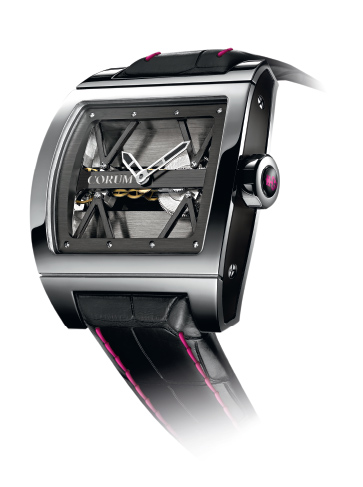
Corum
The watch: Ti-Bridge
A bridge between tradition and innovation. It is hard to imagine any more explicit manner of linking past and future than the Ti-Bridge Only Watch. Its resolutely contemporary aesthetic carved from titanium reveals the second proprietary Corum movement. The new linear CO 007 calibre powering the TI-Bridge is inspired by the Golden Bridge calibre, the very first one presented by the firm.
While its shape is immediately recognisable, the dimensions, components and technical specifications of the brand's latest release are nonetheless different, testifying to a modern yet understated spirit. The titaniumclad bridges and plates feature meticulous finishing echoing that of the tonneau-shaped case, also in titanium. While the latter material is reputed both for its lightness and for the difficulties involved in machining it, Corum reveals its perfect mastery of these technical constraints. The titanium crosspieces holding the movement inside the case contribute to the pleasing and exclusive aesthetic appeal of this unique model.
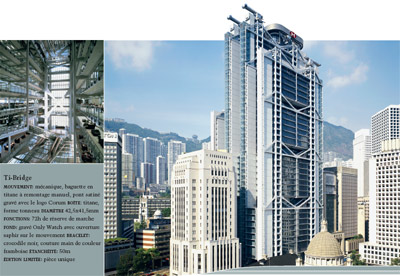
Its architectural counterpart: the Hong Kong and Shanghai Banking Corporation headquarters in Hong Kong designed by Norman Foster
“A comparison between the two constructions showed us various common denominators. The sheer volume of the objects and their inner spaces are deliberately displayed and reveal several formal principles: this process serves to connect the inner and outer areas of these objects and thus reduce the visual impact of the ‘skin' or the limits of the volumes. The use of transparency also sets the stage for the internal structure of the objects, thereby modifying the graphic value of the treatment applied to the exterior, since the latter is eliminated and replaced by an engineering aesthetic: the inner workings and the supporting structure of the objects become the medium of a value geared towards their reason for being and functionality rather than toward decorative aspects.
The internal strata of the objects are clearly visible, since the various elements are superimposed: the transparent wall serves as an interface between inside and outside, the signposting and the visual information one wishes to convey, the frame or the supporting structure as well as the machinery that enables the object to operate. This approach stems from the development of an industrial aesthetic that first emerged in the mid- 19th century and of which the most famous exponents are the architects Peter Behrens, Walter Gropius, Mies Van de Rohe, Philip Johnson, as well as Renzo Piano and Richard Rodgers.”
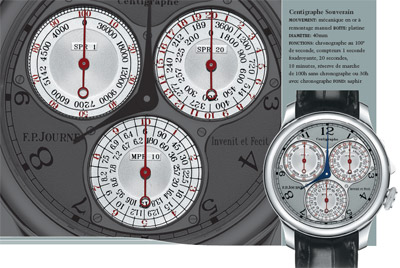
F.P.Journe
The watch: Centigraphe Souverain
In presenting the Centigraphe Souverain, which earned the Golden Hand award in the 2008 Geneva Watchmaking Grand Prix, François-Paul Journe once again caused a sensation by pushing back the limits of horological feasibility. His mechanical hand-wound chronograph theoretically serves to measure an object moving at the speed of 360,000 km/h – meaning well over the escape velocity of a rocket going into low-level orbit!
An impressive feat illustrated by the three chronograph counters arranged around the dial. The jumping or flying seconds hand at 10 o'clock sweeps around the subdial in one second on a scale marked in hundredths of a second; while the hand on the subdial at 2 o'clock completes one turn in 20 seconds. The third dial at 6 o'clock with a hand revolving in 10 minutes is rimmed by a tachometric scale running from 1 to 10, with speeds corresponding to 20-second markers.
Two patents have been filed for this new invention: the first for the chronograph start/stop/reset rocker device at 2 o'clock; and a second for the ingenious configuration of the mechanism that serves to isolate the chronograph function from the movement so as to ensure that the amplitude of the balance is unaffected when the chronograph is running.
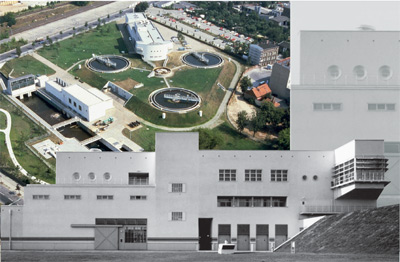
Its architectural counterpart: phosphate elimination plant, Tegel (Berlin) by Gustav Peichl
“Once engaged in this comparative game, the similarities we found between a refined object – in this case the Centigraphe Souverain – and the phosphate elimination plant might seem funny to some. It would indeed be very tempting to compare the horological instrument to an ostentatiously ‘beautiful' architectural achievement.
While such is clearly not the option we have chosen, a closer look at the two does indeed reveal certain points of convergence. Like the building buried in the ground in Berlin, the first impression emanating from an examination of the Centigraphe is that of the powerful presence of three subdials accompanying the time indication. Paradoxically, the presence of these subdials as complements to the standard usage of a watch eclipses the main function of this object and endows it with an enigmatic character. This gives an attentive viewer several clues to interpreting both objects: the insertion of the subdials (or the liquid containers) that “transcend” the base to which they are applied; the diversion of established functions to serve a particular image; the subtle play between the elements arranged on the factory site and the watch surface; and finally, finally, the position that is given to the circular elements, since they are arranged on a specific ‘base' and are characterised by the use of geometrical principles featuring a suggested symbolism lending itself to a number of different interpretations.”
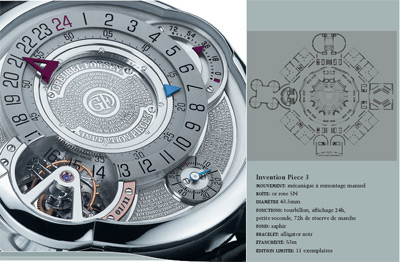
Greubel Forsey
The watch: Invention Piece 3
Greubel Forsey is a brand determined to play an active role in developing the most creative micromechanical inventions of our era. Stemming directly from the research conducted on the Double Tourbillon 30°, the third invention features a single tourbillon cage inclined at a 25° angle and performing a rapid rotation in 24 seconds. This resolutely original mechanism reveals its functions on a dial distinguished by a completely unconventional architectural setting, since the plates themselves serve as the base for the various indications.
The hour dial with its 24-hour display occupies the majority of the space available, while the minute subdial is concentric with that of the dial, with differentcoloured indexes serving to differentiate between them. This cleverly orchestrated aesthetic construction radiates a balance that is further emphasised by the power reserve at 2 o'clock and the tourbillon at 8 o'clock. Moreover, four gold plates are engraved with a portion of a personal message from Robert Greubel and Stephen Forsey, providing insight into the complex process involved in creating this watch and its mechanism. This message, inscribed in full on the back of the watch, emphasises the particular ties that are woven with the owner of this exceptional watch issued in a limited edition of just 33 – 11 in white gold, 11 in red gold and 11 in platinum.

Its architectural counterpart: Sher-E-Bangla Nagar, Louis I. Kahn's capital complex national assembly building in Dhaka, Bangladesh
“Louis I. Kahn has always disciplined himself to use materials in accordance with their inherent natural essence. In his view, technical accomplishments must be vivified by a sense of reality and by personal taste. Moreover, in revisiting the debate instigated by modern architects with regard to the relationship between container and content, Louis I. Kahn postulated that shapes, structures and rules exist through tradition; nonetheless, new works, while complying with tradition, must be imbued with originality in order to have value. A planimetric vision of the Dhaka national assembly consists of a building (the main assembly room) set in the centre of the composition with several volumes gravitating around it (featuring various shapes and housing all the premises complementing the central construction).
In formal terms, the dial design of the ‘Invention Piece 3' watch shows certain similarities with this particular building, as well as evoking the artistic formalisation precepts described by Louis I. Kahn. According to the basic premise put forward by Louis I. Kahn, the uniqueness of the work is achieved by underscoring certain formal principles acknowledged by a majority of people and by then reinterpreting them. These are indeed the kind of principles that are echoed in the design of the watch created by Greubel Forsey…”








